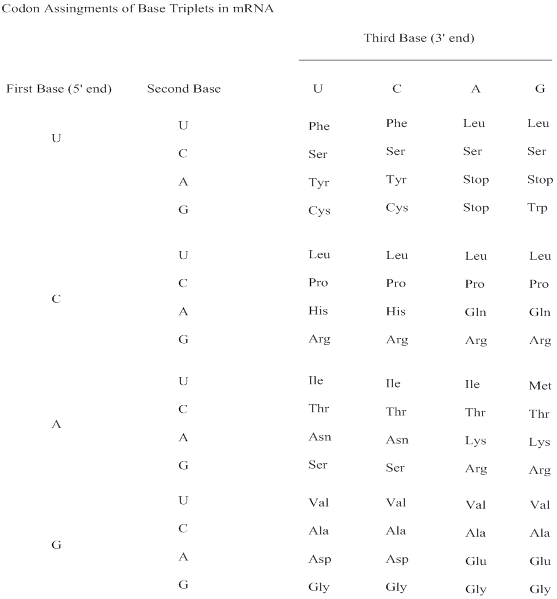
Concept explainers
Interpretation:
The amino acids those have most codons and least codons; reason for multiple codons for certain amino acids has to be interpreted.
Concept Introduction:
Codon: A sequence of three ribonucleotides in the mRNA chain that codes for a specific amino acid; also a three-
Genetic code: The sequence of nucleotides, coded in triplets (codons) in mRNA that determines the sequence of amino acids in protein synthesis.
Translation: A tRNA molecule is a single polynucleotide chain held together by regions of base pairing in a partially helical structure. An amino acid is bonded to its specific tRNA by an ester linkage. Connecting specific amino acid at end of the tRNA is known as charging tRNA. Once done, tRNA is ready to be used in the protein synthesis.
At the other end of the tRNA, three anticodons are present which are complementary to the codons present in mRNA. Once the anticodons pairs off with codons, the amino acid at terminal end of the tRNA is delivered and attached to the growing protein chain.

Illustrated relationships are:
DNA informational strand: 5’ ATG CCA GTA GGC CAC TTG TCA 3’
DNA Template strand: 3’ TAC GGT CAT CCG GTG AAC AGT 5’
mRNA: 5’ AUG CCA GUA GGC CAC UUG UCA 3’
protein: Met Pro Val Gly His Leu Ser
Notice: 5’ end of the mRNA strand codes for the N-terminal amino acid, whereas the 3’ end of the mRNA strand codes for the C-terminal amino acid. Proteins are always written N-terminal to C-terminal, reading left to right.
Want to see the full answer?
Check out a sample textbook solution
Chapter 26 Solutions
EP FUND.OF GENERAL,ORG...-MOD.MASTERING
- Pls help with these three questionsarrow_forward11. Which of the compounds below is the major product of the following reaction sequence? NOTE: PCC is pyridinium chlorochromate 1. BH 3 PCC 2. H2O2, NaOH NH HN ΗΝ, A B C CH3NH2, NaBH3CN D E NHarrow_forward10. Which of the compounds below is the major organic product obtained from the following reaction sequence? Ph Ph Ph A B OH 1. EtMgBr H2CrO4 Zn(Hg), aq. HCI PhCHO ? 2. H₂O, H+ Ph. C D Ph "ར HO OH Earrow_forward
- 7. What is the major organic product obtained from the following reaction sequence? Ph A OH 99 Ph OH D Br HOCH2CH2OH H2SO4 1. Mg, Et₂O 2. PhCH2CHO HCI, H₂O Br OH Ph Ph OH B C Br OH Ph Earrow_forwardPls helparrow_forwardH₂N NH peptide_0e60 A dipeptide is made up of two (2) amino acids. The figure above shows one such dipeptide with an unknown sequence. Your task is to find out the two (2) letter sequence of this dipeptide.arrow_forward
- carbons in each of the structures below. For instance, the central carbon of chloromethylbutane (pictured 3. A chiral carbon is a carbon that is single-bonded to four different types of groups. Identify the chiral above) is a chiral carbon. (Can you see how the groups attached to it are all chemically different?) In each of the chiral molecules below, identify all the carbons that are chiral carbons by drawing a circle around each one of them. (a) the carbohydrate glucose H O (b) the carbohydrate fructose CH₂OH 1C H-C-OH 3 HO-C-H 4 H-C-OH 5 H-C-OH 6CH₂OH D-Glucose (linear form) (c) the amino acid leucine O O H3C. HO H H- -OH CH 3 NH2 H- -OH CH₂OH OHarrow_forwardWe always include controls in the Annexin-V-GFP/Propidium Iodide flow cytometric assay to study apoptosis. List four types of controls in this assay. Why do we need these controls? Explain your answers. After the flow assay, if we like to examine the morphology of the viable, early apoptotic and late apoptotic cells by confocal microscopy, what can we do and what are the expected results?arrow_forward3. (2 points) Your lab partner accidentally used a pen instead of a pencil to mark the baseline and label the lanes of their TLC plate. Briefly (1-2 sentences for each point) describe (a) what would happen to the ink when you develop the TLC plate; and (b) how this would affect the experiment. 1arrow_forward
 Human Heredity: Principles and Issues (MindTap Co...BiologyISBN:9781305251052Author:Michael CummingsPublisher:Cengage Learning
Human Heredity: Principles and Issues (MindTap Co...BiologyISBN:9781305251052Author:Michael CummingsPublisher:Cengage Learning Biology Today and Tomorrow without Physiology (Mi...BiologyISBN:9781305117396Author:Cecie Starr, Christine Evers, Lisa StarrPublisher:Cengage Learning
Biology Today and Tomorrow without Physiology (Mi...BiologyISBN:9781305117396Author:Cecie Starr, Christine Evers, Lisa StarrPublisher:Cengage Learning Biology (MindTap Course List)BiologyISBN:9781337392938Author:Eldra Solomon, Charles Martin, Diana W. Martin, Linda R. BergPublisher:Cengage Learning
Biology (MindTap Course List)BiologyISBN:9781337392938Author:Eldra Solomon, Charles Martin, Diana W. Martin, Linda R. BergPublisher:Cengage Learning
 Biology: The Dynamic Science (MindTap Course List)BiologyISBN:9781305389892Author:Peter J. Russell, Paul E. Hertz, Beverly McMillanPublisher:Cengage Learning
Biology: The Dynamic Science (MindTap Course List)BiologyISBN:9781305389892Author:Peter J. Russell, Paul E. Hertz, Beverly McMillanPublisher:Cengage Learning BiochemistryBiochemistryISBN:9781305577206Author:Reginald H. Garrett, Charles M. GrishamPublisher:Cengage Learning
BiochemistryBiochemistryISBN:9781305577206Author:Reginald H. Garrett, Charles M. GrishamPublisher:Cengage Learning





